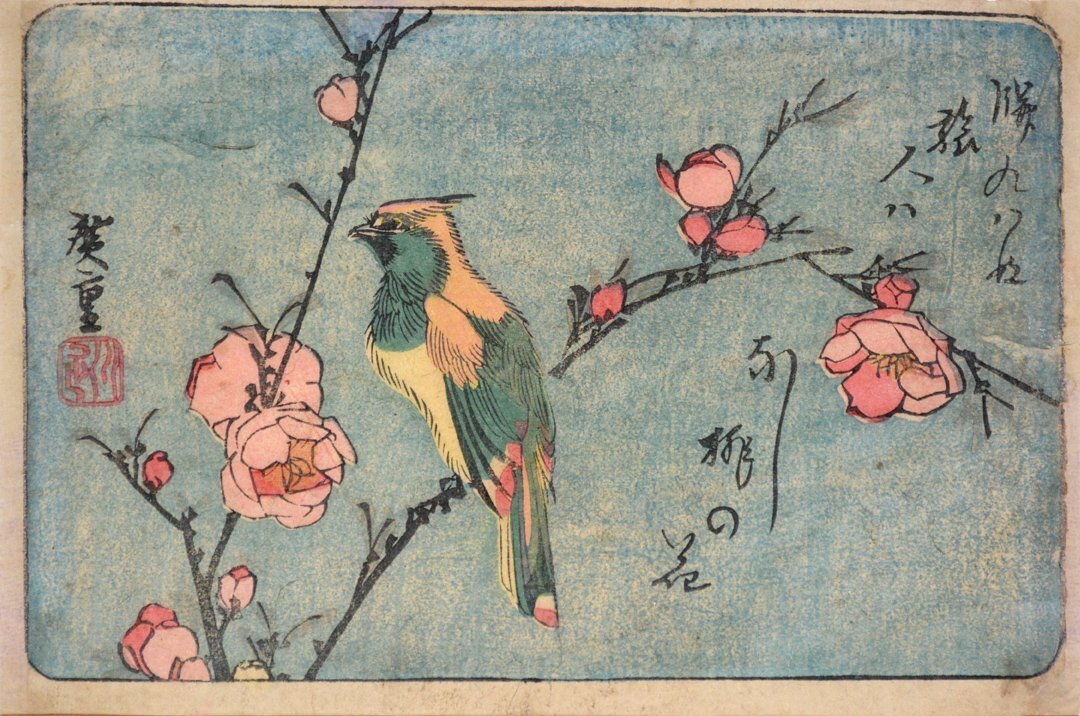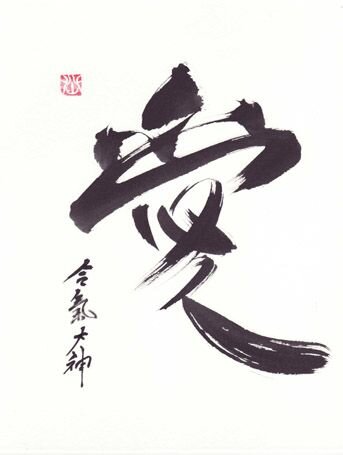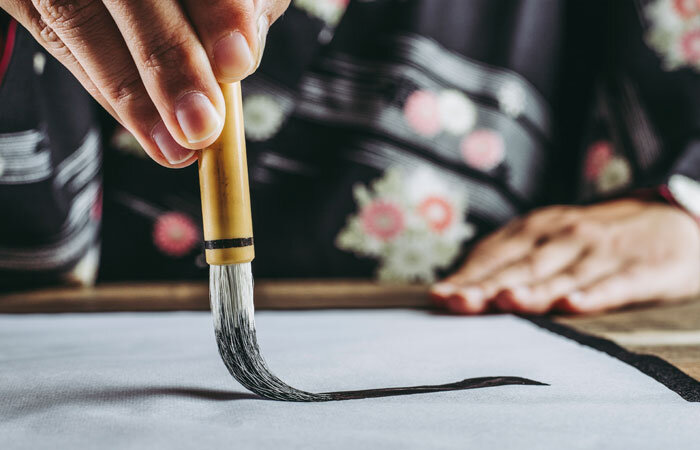Discovering the
Artist Hokusai
The Signature of Hokusai
Hokusai was born in 1760 to an artisan family, in Edo, Japan. Hokusai began painting around the age of six, possibly learning the art from his father, painted of designs around mirrors.
Self Portrait of Hokusai at the age of eighty three.
Hokusai was known by at least 30 names during his lifetime. Although the use of multiple names was a common practice of Japanese artists of the time, the numbers of names he used far exceeds that of any other major Japanese artist. Hokusai's name changes are so frequent, and so often related to changes in his artistic production and style, that they are useful for breaking his life up into periods.
Hokusai studied under a Japanese master artist named Shunshō for over 30 years. He then suffered the death of his wife in the 1790’s. He remarried and his second wife also died within a short time. Therefore he suffered two great losses in his life. This might be one reason for his symbolism of giant waves overtaking small fishing vessels depicting life’s storms that come unsuspecting?
The style of art that Hokusai practiced is called ukiyo-e. It is a form of art that looks much like a comic book. In fact, the comic book style that we are aware of in the west finds its roots in ukiyo-e. This style is very decorative and many European artists in the late 1800’s adapted much of the visual language of Japan through the ukiyo-e prints that they obtained. Artists such as Vincent van Gogh, Monet, Manet, and Klimpt reflect a strong Japanese influence in their work.
Woodcut Paintings by Hokusai
As Hokusai grew as an artist he left painting traditional Japanese scenes and focused on landscapes and images of daily life. He continued to change his name, his art became widely published, and he had over 50 students. His fame grew and there is a legendary story of an art competition he won. Hokusai was invited to compete with another artist who practiced more traditional brush stroke painting. Hokusai's painting, created in front of the Shogun (a military ruler), consisted of painting a blue curve on paper, then chasing a chicken across it whose feet had been dipped in red paint. He described the painting to the Shogun as a landscape showing the Tatsuta River with red maple leaves floating in it, winning the competition.
The Great Wave by Hokusai is his most famous work of art.
In 1811, at the age of 51, Hokusai changed his name to Taito and entered the period in which he created the Hokusai Manga and various art manuals. These Quick Lessons in Simplified Drawing, served as a convenient way to make money and attract more students. The first book of Hokusai's manga, sketches or caricatures that influenced the modern form of comics known by the same name, was published in 1814. Together, his 12 volumes of manga published before 1820 and three more published posthumously include thousands of drawings of animals, religious figures, and everyday people.
In 1820, Hokusai changed his name yet again, this time to "Iitsu," a change which marked the start of a period in which he secured fame as an artist throughout Japan (though, given Japan's isolation from the outside world during his lifetime, his fame overseas came after his death). It was during the 1820s that Hokusai reached the peak of his career. His most famous work, 36 Views of Mount Fuji, including the famous Great Wave off Kanagawa, dated from this period. It proved so popular that Hokusai later added ten more prints to the series. the extraordinarily detailed Poppies and Flock of Chickens. The next period, beginning in 1834, saw Hokusai working under the name "Gakyō Rōjin Manji" (The Old Man Mad About Art).
Ducks in A Stream
In the postscript to this work, Hokusai writes: “ From around the age of six, I had the habit of sketching from life. I became an artist, and from fifty on began producing works that won some reputation, but nothing I did before the age of seventy was worthy of attention. At seventy-three, I began to grasp the structures of birds and beasts, insects and fish, and of the way plants grow. If I go on trying, I will surely understand them still better by the time I am eighty-six, so that by ninety I will have penetrated to their essential nature. At one hundred, I may well have a positively divine understanding of them, while at one hundred and thirty, forty, or more I will have reached the stage where every dot and every stroke I paint will be alive. May Heaven, that grants long life, give me the chance to prove that this is no lie. ”
In 1839, disaster struck as a fire destroyed Hokusai's studio and much of his work. By this time, his career was beginning to wane as younger artists such as Andō Hiroshige became increasingly popular. But Hokusai never stopped painting, and completed Ducks in a Stream at the age of 87.
"If only Heaven will give me just another ten years... Just another five more years, then I could become a real painter."
Hokusai
Ducks in a Stream, painted when Hokusai was 87, shows two mallards diving into a stream of water in search of food. In the center of the vertical scroll, which encourages the eye to move downward, one duck is shown above the water, both body and beak clearly visible to the audience, while another duck, beneath, dives through the diagonal lines that signify the rushing water. The ducks are depicted with a great deal of detail and color while the stream is represented only by eight bands of grey, with shadows of weeds surrounding the birds themselves and red maple leaves floating atop the surface, suggesting it is autumn.
Despite the simplicity of the composition, Hokusai's approach is experimental, combining a naturalistic approach to the birds, which are built up with small strokes of paint, with a more symbolic and sparse treatment for their fluid environment. The depths and motion of the water is suggested through the modulated washes of grey and the shifts in brightness and clarity to indicate the positioning of the water itself. The work's meaning is somewhat ambiguous, with Hokusai seemingly overlooking the traditional association of ducks with marital fidelity in favour of a more straightforward representation of the natural world in which the birds hint, instead, at the changing of seasons and passing of time, evoking an emotional response.
Constantly seeking to produce better work, he apparently exclaimed on his deathbed, "If only Heaven will give me just another ten years... Just another five more years, then I could become a real painter." He died on April 18, 1849, and was buried at the Seikyō-ji in Tokyo (Taito Ward).
Your assignment:
Hokusai sought to capture movement in his art. The golden mean or law of thirds came into his style and visual attitude. Observe the lines only in his image of The Waves of Kanazawa below. It appears every line has movement and direction. Your lesson is to observe the photos below of waves and to draw them in your sketchbook in a Hokusai style where every line appears to show movement. Create at least two drawings to this purpose and label the top of the page or pages Hokusai inspired drawings.
Photos for your drawings: Choose one or both of the photos below to draw in a Hokusai style depicting movement. Observe closely the line drawing above to help you along. Show the images on your computer as you draw from them in your sketchbook.
A Personal Reflection On the Culture
Many years ago I traveled across China as a photographer. There were several dynamics about their culture that remained with me. I was very impressed with how orderly the airport in Tokyo was. Military Police were everywhere. The airport was so clean you could eat off the floor. There was perfect organization everywhere I looked. As I traveled from city to city I noticed that there were no homeless people, even in the heart of a busy city I discovered order and organization that always left a deep impression in my mind. The Chinese ate using several small dishes of food that would be passed around within the family. I counted at least 13 plates of food each meal, from dumplings to noodles of every sort.
The dynamic of being largely Buddhist with regards to religion meant that the culture was mindful of living in the moment. They are a very patient culture when it comes to infrastructure. Many projects would take more than a lifetime to complete. The art reflects this meditative mind set with what could be called Zen Art. It is art that focuses on every detail of a leaf or bird taking nothing for granted.
A train in the Tokyo Airport Multiple Dishes Make Up A Chinese Dinner A Zen Style Painting of a Bird
Cultural Dynamics to Discover:
Language:
View the short videos below to see how Chinese words are formed. One of your assignments will be to construct four sentences within the Chinese format of compounding words for meaning. Your complete assignments are at the bottom of this page.
Chinese characters, also called Hanzi (simplified Chinese: 汉字; traditional Chinese: 漢字; pinyin: Hànzì; lit.: 'Han characters'), are logograms developed for the writing of Chinese.[2][3][4] They have been adapted to write other Asian languages, and remain a key component of the Japanese writing system where they are known as kanji. Chinese characters are the oldest continuously used system of writing in the world.[5] By virtue of their widespread current use in East Asia, and historic use throughout the Sinosphere, Chinese characters are among the most widely adopted writing systems in the world by number of users.
In modern Chinese, most words are compounds written with two or more characters. Unlike an alphabetic system, a character-based writing system associates each logogram with an entire sound.
Egyptian hieroglyphs
In a written language, a logogram or logograph is a written character that represents a word or morpheme. Chinese characters (pronounced hanzi in Mandarin, kanji in Japanese, hanja in Korean and Hán tự in Vietnamese) are generally logograms, as are many hieroglyphic and cuneiform characters. The use of logograms in writing is called logography, and a writing system that is based on logograms is called a logography or logographic system.
Calligraphy
Japanese and Chinese calligraphy is an art form completely all its own. The beauty of letters and words are created using special brushes, rice paper and ink. A simple word takes on a life of its own as if it were a piece of visual music. In the west, we only use unique fonts for expression.



















